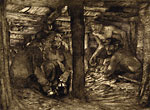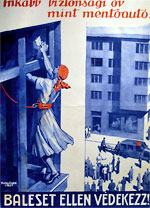A World Gone Missing
Some Eckblad prints reflect the viewpoint of the mine or mill owner. A 1920 French poster shows a Peugeot plant as only an owner could picture it: happy drivers of Peugeot cars, happy Peugeot workers riding bicycles, a factory that looks like an art deco garage stretching behind them, and, surveying the cornucopia, a roaring lion symbolizing what you will—the heirs to this family business, their exhilarated customers, or the joys of being a circus performer no longer. Yet the lion would not roar unless all these people and machines were headed out of the plant. If they were headed into the plant, the dour Robert Burns at their head, the lion would realize how different that was, and go back to his cage. Peugeot’s workers and customers would feel the same way. Nor would their children be sitting in the back seat, expecting a picnic.
Another French print of the same period shows the advantages of the public’s subscribing to a government loan: men build stone walls and plough fields, steamers leave harbor, and factory chimneys smoke. All is grime and creases. The two oxen that pull the farmer’s plough do for this scene what the lion does for the Peugeot phantasmagoria: men aspire to be beasts. Yet this impression is belied by the scene in the foreground, where a buxom mother gives suck to an infant while her young daughter nestles beside her, reading. Here is what the men get for their work: happy, stay-at-home women. And the country gets more workers and taxpayers to fill the human vacuum left by World War I.
The viewpoint of the worker, that elusive figure to whom Burns spoke, appears in some works in Eckblad’s collection and also in left-wing books and magazines that seldom come on the market. Sometimes the artist interests himself in the worker’s viewpoint, and asks, What are they thinking? An 1898 lithograph of French coal miners answers: do not ask! They are not thinking—thought is dangerous!—but merely existing. The miners in a later print, of 1937, also strike an unreflective pose, but not a passive one. That was a big year for workers—the United Auto Workers gained recognition from General Motors.
GM was what it remained until this year—the biggest manufacturer in the country. For the UAW to organize this company was an American answer to the questions that Burns had not put into words. Is anyone in there? Can we talk? Now the answer would come from a union. And now a man like John Eckblad could now embark on the industrial mediating career that led to this collection.
Beginning mainly in the 1930s, some artists tried to show not what they saw themselves, but what they supposed workers saw. First came the notion that a worker would see that the scale of all things industrial was against him. He was a midget, and his employer was a giant. The American left-wing artist Hugo Gellert captured this notion in one of the drawings he did to illustrate Karl Marx’s Capital The workers are not leaving the plant on bicycles of their own manufacture; they are trying to get into the plant.
‘I’m no longer building my collection, my collection is building me.’
Few prints show factory work from the inside. Even the assiduous John Eckblad found only a handful of examples. Most portray actual or possible industrial accidents; predictably they were commissioned by plant owners who feared their men would go union partly because of unsafe working conditions. To halt this menace, the prints say that industrial accidents occur because of workers’ carelessness. Not one of them admits that workers’ carelessness is seldom uncompounded by poor lighting, faulty equipment, speed-up, fatigue, and bad luck. They are simple, these prints, but not in Gellert’s facile way. One, from the fascist Hungary of the 1930s, shows a man turned upside down on a pulley. Another from the same time and place warns of the dangers of washing skyscraper windows. This second, sunnier print may reflect the difficulty unions have always had in organizing window washers and others who work outdoors alone or in small, unsupervised groups. Mines and mills have always been easier to organize.
Why, among all these prints, were so few drawn by workers? Leisure time in a mine or mill, or on a railroad or a boat, is a peculiar creature. Yes, there is some leisure time, something never found on an assembly line. Leisure time comes in big enough chunks for workers to read. On ships, it came in big enough chunks for sailors to carve scrimshaw. It does not come in big enough chunks to take out an easel and draw. Drawing is more contemplative than reading or even carving. When this writer was a subway motorman in New York Post, he found it easy to stop his train at a red signal underneath Times Square, pick up the , and read Jimmy Breslin or check the odds on the next Giants game. He could never have peered into the dark, found something to draw, and drawn it, all before the light turned green.
The luxury of looking! Of collecting! Burns didn’t understand. He wasn’t Romantic enough.
Selections from the Eckblad collection will be shown at the Frances Lehman Loeb Art Center of Vassar College (Jan. 22–Mar. 21, 2010); at the Palmer Museum of Art at Penn State, (Oct. 19–Jan. 23, 2011); and the Taft Museum of Art in Cincinnati (Mar. 4, 2011–May 15, 2011).
 ABOUT THE COLLECTOR John Eckblad earned a Ph.D in organizational psychology from Case Western Reserve University. He is the author (with David Kiel) of If Your Life Were a Business, Would You Invest In It? (McGraw-Hill, 2003) and the creator of the Life Business™ Program. For more than twenty years, Eckblad worked in Europe as an organizational consultant to numerous international corporations, including Procter & Gamble, Royal Dutch Shell, and ICI (Imperial Chemical Industries). He and his wife have six children and divide their time between Chapel Hill, North Carolina, and Paris, France.
ABOUT THE COLLECTOR John Eckblad earned a Ph.D in organizational psychology from Case Western Reserve University. He is the author (with David Kiel) of If Your Life Were a Business, Would You Invest In It? (McGraw-Hill, 2003) and the creator of the Life Business™ Program. For more than twenty years, Eckblad worked in Europe as an organizational consultant to numerous international corporations, including Procter & Gamble, Royal Dutch Shell, and ICI (Imperial Chemical Industries). He and his wife have six children and divide their time between Chapel Hill, North Carolina, and Paris, France.










